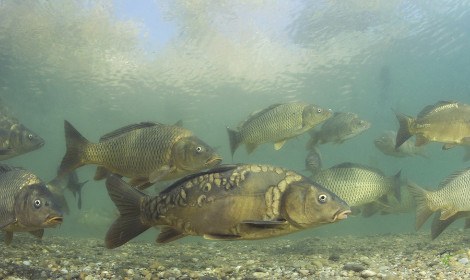
Coarse fishing is a science within itself. From many different fishing techniques to specialized equipment for each method, you need to gather a wealth of information about coarse fish before becoming a good angler.
But how can a casual learner turn into an expert in the field of coarse fishing? By research and by practice, of course. However, while you can get a lot of coarse fishing practice while fishing at any of the commercial fisheries dotting the UK, where can you get your research from? Right here!
So, what are the different types of coarse fish? How can you tell them apart? What do you need to know about them before you cast a line? To become an expert angler, you should know all that there is to know about the different types of coarse fish, their feeding habits, and the distinctive features you can use to tell them apart.
If you’re wondering about all of these things, you’ve come to the right place. It is essential to gather this information because coarse fishing is an activity that needs research as much as it requires practice.
So, what are you waiting for? Let’s get into it!
Species Of Coarse Fish
A quick internet search will reveal several results for coarse fish species. But which species did you catch on your last fishing trip? One thing that many newbie anglers struggle with is differentiating between all the similar-looking species of fish. If you ask them, everything is a carp in their eyes!
So, are you ready to take a step closer to becoming a professional angler? If so, it’s time to put on your reading glasses and dive into an in-depth piece on the different species of coarse fish that possibly inhabit your local fishing spot.
Bream
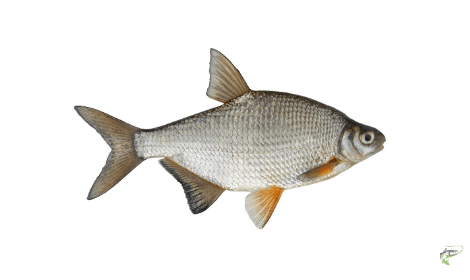
If you’ve caught a slim, slimy fish, it’s probably a bream.
Typically found in still waters, bream is a common species of coarse fish. It typically feeds near the bottom and is termed as a ‘bottom-feeder’ just like carp.
Bream are omnivores that feed on almost anything they can find — small crustaceans, fish, algae, mollusks etc. They’re all fair game for breams!
But how can you tell when you’ve caught a bream? Let’s see.
Distinctive Features
Bream is a fish species so widely distributed in the water that its population is not even slightly affected by anglers continuously catching them. This widespread distribution shows that it is one of the commonest catches for anglers.
So, how can you positively identify bream? They have translucent, silver-grey scales. This silver-grey turns slightly bronze the older that bream grow. They are also deep-bodied, which means their bodies are flattened from the sides but have a tall physique.
They grow to lengths ranging from 1-2 feet while weighing anywhere from 5-8 lb. Anglers use the pectoral fin sometimes to identify bream. This technique depends on the pectoral fin’s colour as it takes on a reddish hue as the bream grows into an adult.
Barbel
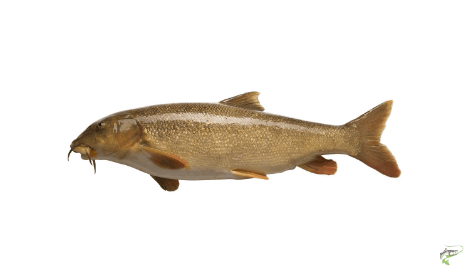
Some species are easy to remember because their names tell you their most important feature.
Barbels are known for the pairs of barbels extending from the sides of their mouth. These barbels help them to judge food based on smell and touch. They also grow rapidly and are powerful.
Barbel usually feeds at the bottom and scavenge for food such as crustaceans, snails, mollusks, etc., near the river or lake bed.
Distinctive Features
Barbel has a typical bottom-feeder mouth. Which mouth is that you wonder? Bottom-feeders typically have mouths that point downwards, which helps them scavenge food more efficiently at the bottom of the water.
They also have pairs of two fleshy barbels on each side of their mouth. These barbels are what give this fish its name. Sizes can widely vary, with some barbel growing to 1.5 inches only and others growing to over 21lbs in the UK.
Barbel is light green to light brown. Anglers can also identify them by their large, reflective scales.
Carp
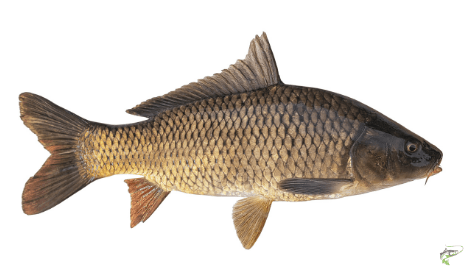
Who doesn’t what a carp looks like? After all, it is quite possibly the most beloved coarse fish in the UK.
Carp are typical bottom feeders with downwards-pointing mouths. Most anglers love catching carp, and carp fishing has become one of the most popular sports in many parts of the world.
There are several carp types in the UK, an in-depth guide of which you can find here.
The most common carp types that most anglers catch are the common carp, mirror carp, and leather carp. Other types include species such as grass carp, koi carp, etc.
Distinctive Features
Most carp types are usually brownish-yellow in colour, have prominent scales and a downwards-pointing mouth that indicates their bottom-feeder status.
Carp, much like barbel, also have two pairs of barbels at the sides of their mouth. These barbels help them judge their food as dangerous or safe.
Common carp have a uniform arrangement of scales. Mirror carp differ from them because they have irregularly arranged scales. They are also fewer in number than the scales on common carp. Anglers call it leather carp because its body has a leathery feeling. This feeling comes from the fact that the leather carp does not have any scales on its body.
Pike
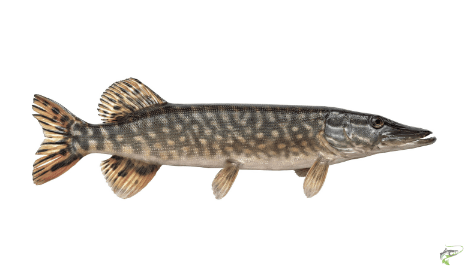
This species scares all the smaller fish. Why is that? Well, let’s find out.
Known as Northern Pike in other parts of the world, the pike has long since been a common predator in most waters, especially those of the UK. They are green in colour, with lighter spots covering their entire body. They are deadly attackers and can use the sharp teeth in their mouth and their gills to capture the prey.
Distinctive Features
Pike have a vast mouth that they use to grab onto large prey. Razor-sharp, deadly teeth line their mouths. Their greenish colour allows them to effectively camouflage themselves in the water, making them excellent predators. Their bellies are lighter than the rest of their bodies.
Pike grow to relatively large sizes, with some pike weighing as much as 45 lbs.
Gudgeon
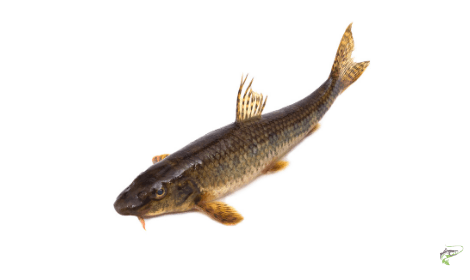
Gudgeon is quite possibly the most uncomplicated fish among all of the coarse fish.
Gudgeon are small, edible fish that most anglers use as bait. They are members of the carp family. One can usually find them in fast-flowing waters such as rivers, etc. They tend to feed on smaller animals or fish.
Gudgeon, much like other members of the carp family, are bottom feeders.
Distinctive Features
Gudgeon have elongated bodies and downward protruding mouths. They are grey-green. There is a fleshy lump called a barbel on each side of the gudgeon’s mouth.
They are relatively small in size and do not go beyond the length of 8 inches. Gudgeon also have small spots lining the sides of their body.
Chub
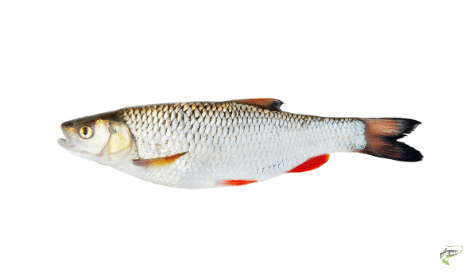
Another angler favourite is the chub. The common chub is also sometimes referred to as the European chub. These chubs typically prey on other small animals, insects, etc. They usually do not grow beyond the length of 2 feet.
They are a popular species of coarse fish. Anglers love catching chub because they fight hard. You can often find chub in shaded, secluded spots such as the spots with branches hanging over them.
Distinctive Features
Chub have giant mouths. They also have large scales that are green and brown. A contrasting black color streaks its edges. In comparison, chubs have very pale bellies. They have rounded bodies, and their snouts are blunt.
Dace
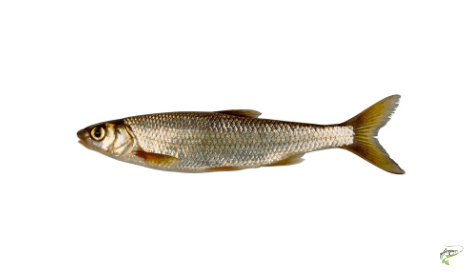
These fish are huge fans of eating whatever comes their way.
Dace are small fish that anglers sometimes confuse with chubs. Anglers typically find them near the surface of the water. Anglers can discover dace in brackish waters as well as rivers and streams. Dace are voracious feeders and will eat almost anything. Most anglers catch dace by using maggots and bread as bait.
Many anglers also use dace as baitfish owing to their small size. Some parts of the world eat dace, but it is mainly considered an inedible coarse fish in the UK and its surroundings.
Distinctive Features
Daces are silvery-blue in colour and have inferior mouths. Their upper jaw is much longer than their lower jaw. They also have a forked tail. Daces have large, silver scales that cover their entire body.
Their bodies are slender, and they are set apart by their bright yellow eyes. Their bellies are lighter in colour than the rest of their bodies.
Perch

Perch are typically freshwater fish with two common types. These types are the common perch and the yellow perch. One commonly finds them near riverbanks, and anglers catch them by using maggots as bait. Anglers can usually them in still, or slow-moving waters.
Unlike other common coarse fish species, perch are not omnivores. Instead, they feed exclusively on smaller fish and larvae.
White perch are considered as coarse fish; some parts of the world also eat them. Anglers like them because they are pretty active fighters when caught.
Distinctive Features
Common perch are typically greenish-brown in colour. Their most striking feature is the set of dark, vertical lines that one can see across their body. They have round bodies and usually grow to a weight of 6.6 lb or so. Their dorsal fins are sharp and pointy.
Yellow perch typically differ from common perch regarding their colour, which is yellow, whereas that of the common perch is greenish-brown. The rest of the yellow perch and common perch morphology is quite similar to each other. However, yellow perch have a rougher body than common perch because of the yellow perch’s ctenoid scales.
Roach
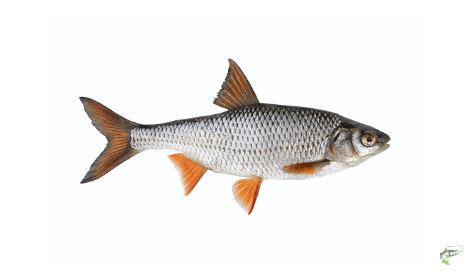
If you’re wondering if we’re talking about the insect roach, the answer is no.
This roach is a species of coarse fish that anglers love to catch. Roach is similar in shape to carp. They are not very big, and anglers usually catch them as a sport. They are a robust species of fish that can survive in extremely harsh conditions as well.
Their population in local rivers and lakes is a large one. Roach are omnivores that eat various food such as plants or algae and small invertebrate animals and maggots, etc.
Distinctive Features
Roach has a metallic silver-blue colour. Their fins contrast from the rest of the silver body by being red-brown. Roach, like most other coarse fish, has a pale belly. They also have red eyes and are relatively small in size.
Their back is darker in colour as compared to the rest of their body. Young roaches are more slender as compared to older ones. Fishers identify roach by unmistakable red mark over their pupil.
Rudd
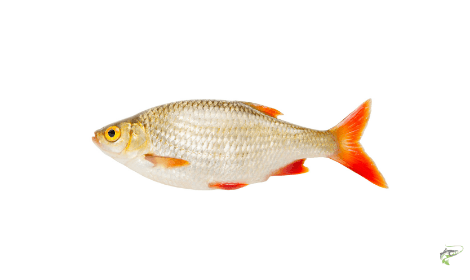
It’s time to concentrate intently because many people confuse rudd with roach. Rudds are more colourful than other coarse fish. However, roaches can easily be differentiated from rudd by the red marks in their eyes. It is usually present in slow-moving waters with a lot of vegetation.
Rudd are omnivores, usually eating any plants, insects, etc. However, older ones tend to have more herbivore eating patterns. Similar to carp, people also consider rudd to be destructive species. However, many people treat them as game fish in some parts of the world.
This status is because they tend to dirty any water they inhabit, destroy all vegetation in that particular part of the water and compete with other smaller fish species for food.
Distinctive Features
Their fins are orange in colour, while the rest of their body is present in varying shades of silver and orange. They are deep-bodied and built stoutly. They have shiny, reflective scales that are silver in colour.
They usually do not grow beyond 14-15 inches. Rudds have mouths that point upwards, as this allows them to feed more quickly near the surface. They also look greenish-yellow at times.
Tench
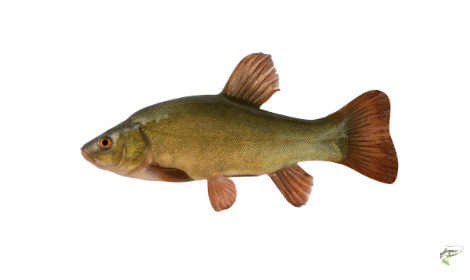
Tench are, interestingly, also called ‘the doctor fish.’ Anglers usually find them in shallow waters that have a lot of vegetation in them. Tench also have fleshy barbels extending from the sides of its mouth. They use these barbels to judge their food.
They are referred to as doctor fish because an old wives’ tale describes them as the fish that other sick fish rubbed against to get healthy again.
This doctor fish usually inhabits muddy, brackish waters. Although they are omnivores, tench show a marked preference for small animals. They are very tough and can withstand various conditions such as low oxygen concentration in the water, muddy waters, and a high vegetation level.
Tench are considered to be even more adaptable than carp and can survive many harsh conditions.
Distinctive Features
Tench are carp-like in body shape. They have a light green colour that becomes golden as it goes lower. Tench also have barbels on each side of their mouth. However, these barbels are smaller than the typical barbels that one sees in coarse fish.
Tench have tiny scales and a broad, square tail. They have an extremely slimy exterior, which makes them highly slippery upon catching. They also have small, reddish eyes.
Ide
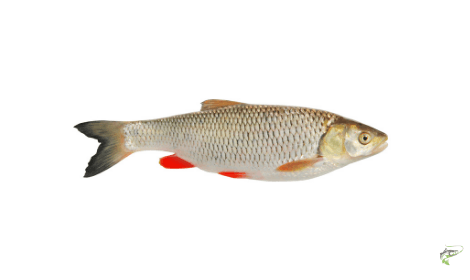
Ide is another coarse fish that looks similar to carp. They are considered edible, and anglers catch them as a sport. They typically reside in large, transparent bodies of water.
While most ides are ornamental, some do escape into larger bodies of water during flooding season. These escapes can lead to an increase in the population of ide. A lot of people confuse ide with chub. However, a closer look can help anglers differentiate between the two.
Indie is usually omnivores, but older ide primarily feeds on other, smaller fish. Anglers also love to catch ide for their habit of fighting hard when caught.
Distinctive Features
Ide has stout bodies that are silvery in colour. They are deep-bodied and have yellow eyes. They usually grow to around 10-12 inches in length. Ide also possesses pharyngeal teeth. Although most ides weigh anywhere between 1 or 2 kg, some anglers have caught ide weighing almost 8 kgs.
That’s All!
Often, many lakes and reservoirs have differing fish populations. Anglers use different techniques to catch various species of coarse fish. That is why they need to modify their strategy according to the kind of fish they are about to catch. To do that, anglers need to know all that there is to know about coarse fish before setting out to catch some.
So, if you want to impress all your friends, or maybe not, with your accurate identifications of the different coarse fish types, it’s time to commit all of this information to memory.


